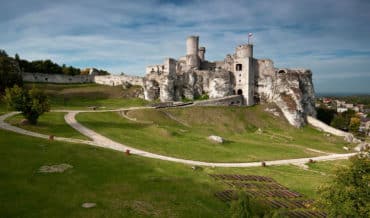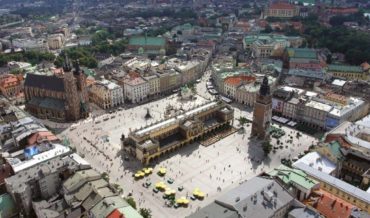Contents
Key Facts
- Born in 1486, died in 1549 (lived 63 years)
- Son of Jakub Boner and nephew of Jan Boner
- Prominent entrepreneur, banker, and patron of arts and sciences
- Inherited the house at Main Market Square 9 with its beautiful attic
- Continued his uncle's work on Wawel Castle reconstruction
- Transformed Ogrodzieniec Castle into an aristocratic family residence
- Had 5 children: daughter Zofia and 4 sons
- His family line ended in 1592 with his youngest son, also named Seweryn
Early Life and Family Background
Seweryn Boner was born in 1486 into one of the most influential merchant families in 16th-century Kraków, according to the Polish Biographical Dictionary. He was the son of Jakub Boner and nephew of the renowned Jan Boner, both prominent figures in Polish Renaissance commerce and banking. The Boner family had established themselves as a dominant force in European banking and trade, with documented connections spanning from Kraków to major commercial centers across the continent.
Historical records from the Central Archives of Historical Records in Warsaw indicate that growing up in this environment of wealth and political influence, Seweryn was exposed from an early age to the intricacies of international commerce, diplomacy, and the patronage of arts that characterized the Polish Renaissance. His upbringing prepared him to continue the family tradition of combining successful business ventures with significant cultural contributions to Polish society.
Business Career and Banking Empire
Seweryn proved himself to be a talented entrepreneur and banker, inheriting not only his family's wealth but also their business acumen. Research by Kozłowska-Studnicka demonstrates that he expanded the Boner banking operations, which had already established branches in major European cities including Venice, Rome, and Antwerp. His financial empire was built on copper mining operations, international trade, and sophisticated lending operations that served both private merchants and royal courts.
The scope of Seweryn's business activities, as documented in Dzieje Krakowa by Bieniarzówna and Małecki, extended far beyond traditional banking. He invested heavily in:
- Copper mining operations in the Kraków region, particularly in the Olkusz area
- International trade routes connecting Poland with Western Europe
- Real estate ventures in Kraków and surrounding territories
- Agricultural estates that provided substantial income
His business strategies were remarkably modern for the 16th century, employing sophisticated financial instruments including bills of exchange and maintaining detailed double-entry accounting records that allowed him to track profits and losses across multiple ventures simultaneously. This approach was revolutionary in an era when most merchants relied on simple record-keeping methods.
Patron of Arts and Sciences
Following in his family's tradition, Seweryn became a distinguished patron of Renaissance architecture and sciences, supporting numerous artists, scholars, and craftsmen throughout his lifetime. His patronage, characteristic of humanist ideals of the period, extended to:
Architectural Projects
- Commissioning decorative elements for churches and public buildings in the Renaissance style
- Supporting the work of Italian architects working in Poland during the architectural transformation
- Financing the creation of ornate residential buildings that showcased Italian Renaissance aesthetics
Scholarly Pursuits
- Funding humanist scholars and their classical research
- Supporting the publication of important literary and scientific works during Poland's Golden Age
- Maintaining a private library that contemporary sources describe as one of the finest collections in Poland
Property and Real Estate Holdings
The Main Market Square Residence
Seweryn inherited the magnificent house at Main Market Square 9, a property that remains one of the most architecturally significant buildings in Kraków's historic center. Visitors can still admire its beautiful Renaissance attic, which features intricate decorative elements typical of 16th-century Polish architecture and represents the sophisticated taste of the Boner family.
The building served not only as a family residence but also as a center of business operations and cultural gatherings. Its strategic location in the heart of Kraków's commercial district made it an ideal base for Seweryn's extensive international business activities.
Political and Administrative Career
Seweryn inherited significant administrative and political positions from his uncle Jan, which provided him with considerable influence in Polish governmental affairs during the Jagiellonian period. These positions included:
- Advisory roles to the Polish royal court under King Sigismund I
- Administrative oversight of various municipal functions in Kraków
- Participation in trade regulation committees governing international commerce
- Diplomatic missions to other European courts, particularly regarding commercial treaties
His political involvement was characterized by a pragmatic approach that sought to balance the interests of the emerging merchant class with the broader needs of the Polish state. This diplomatic skill proved invaluable in navigating the complex political landscape of 16th-century Poland during its economic transformation.
Architectural Legacy
Wawel Castle Reconstruction
Seweryn continued his uncle Jan's crucial work on Wawel Castle's Renaissance reconstruction, contributing both financial resources and organizational expertise to this monumental royal project. According to historical documentation, his involvement helped ensure that the castle's renovation reflected the finest examples of Italian Renaissance architecture, incorporating design elements that transformed the medieval fortress into a magnificent royal residence.
The reconstruction work under Seweryn's patronage included:
- Interior decorations featuring elaborate frescoes and sculptures by Italian masters
- Modernization of residential quarters for the royal court
- Enhancement of ceremonial spaces for state functions, including those connected to Wawel Cathedral
- Integration of defensive medieval features with Renaissance aesthetic considerations
Ogrodzieniec Castle Transformation
One of Seweryn's most ambitious architectural projects was commissioning a complete Renaissance reconstruction of the castle in Ogrodzieniec, located in the Polish Jurassic Highland, transforming it from a medieval fortress into an elegant aristocratic family residence. This undertaking demonstrated his vision for combining medieval defensive architecture with Renaissance comfort and elegance.
The Ogrodzieniec project involved:
- Comprehensive structural modifications to improve habitability while preserving defensive capabilities
- Addition of decorative elements reflecting contemporary Italian Renaissance artistic trends
- Landscaping of surrounding grounds to create an appropriate Renaissance garden setting
- Installation of modern conveniences that made the castle suitable for extended aristocratic residence
Family Life and Legacy
Children and Descendants
Seweryn had five children: a daughter named Zofia and four sons, as recorded in genealogical documents. Despite the size of his family, the continuation of the Boner line faced challenges that ultimately proved insurmountable. Historical records indicate that none of his sons produced heirs, a circumstance that would have significant implications for the family's future influence.
Zofia Boner married into another prominent noble family, carrying Boner influence into different circles of Polish Renaissance society. However, according to inheritance laws of the period, it was through the male line that the family name and primary commercial inheritance were expected to continue.
End of the Family Line
The Boner family's remarkable influence in Polish society came to an end in the late 16th century. The last representative of this branch of the Boner family was Seweryn's youngest son, also named Seweryn, who died in 1592 without heirs. This younger Seweryn had attempted to maintain the family's business interests and cultural patronage, but without descendants, the direct line of this influential merchant dynasty concluded.
The end of the Boner family marked the close of an era in Polish commercial and cultural history, as documented by Samsonowicz, since few other merchant families had achieved such a remarkable combination of financial success, political influence, and Renaissance cultural patronage.
Historical Significance
Seweryn Boner's life and career represent a crucial transition period in Polish Renaissance history, when successful merchant families could achieve social and political influence rivaling that of traditional hereditary nobility. His success in combining innovative business practices with extensive cultural patronage created a model that influenced subsequent generations of Polish entrepreneurs during the country's Golden Age.
His contributions to Kraków's architectural Renaissance heritage, particularly through his patronage of major reconstruction projects, helped establish the city as one of Central Europe's most important Renaissance cultural centers. The buildings and institutions he supported continued to serve Polish society long after his death, creating a lasting architectural and cultural legacy that extends far beyond his 63-year lifetime.
Seweryn Boner died in 1549, having successfully maintained and expanded his family's influence during a period of significant political and economic transformation in Renaissance Poland. His life exemplified the opportunities available to skilled and ambitious individuals during Poland's Golden Age, while his death marked the beginning of the end for one of the era's most influential merchant dynasties.
References
- Polski Słownik Biograficzny (Polish Biographical Dictionary), Volume II, Kraków 1936, pp. 297-300
- Kozłowska-Studnicka, Janina. Bonerowie (The Boners). Kraków: Wydawnictwo Literackie, 1970
- Bieniarzówna, Janina, and Małecki, Jan. Dzieje Krakowa, Tom II: Kraków w wiekach XVI-XVIII. Kraków: Wydawnictwo Literackie, 1984
- Samsonowicz, Henryk. Złota jesień polskiego średniowiecza. Warszawa: Państwowy Instytut Wydawniczy, 1971
- Archiwum Główne Akt Dawnych, Warsaw – Historical documents regarding Boner family commercial activities

